
Mandelbrot Fractal Overview
The Fractal Science Kit fractal generator Mandelbrot fractals encompass several related fractal types including Mandelbrot fractals, Julia fractals, Convergent fractals, Newton fractals, and Orbit Traps.
Mandelbrot Fractals
Mandelbrot fractals are the result of iterating a fractal formula. A fractal formula is a statement like:
z = z^2 + c
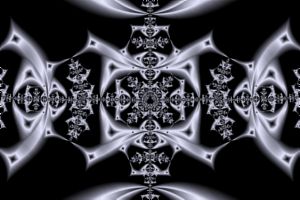 This statement takes 2 complex values found in the variables
z and c, and
combines them based on the expression to the right of the equal sign; in this
case, by squaring z and adding
c to the result. The resulting complex value is
assigned to the variable z, replacing the previous
value of z. This completes the 1st
iteration of the formula. A 2nd iteration would evaluate the
expression again, this time starting with the new value of
z computed in the 1st iteration. This
process continues with each step producing a new value for
z. The process terminates when the
magnitude of z
exceeds some threshold value or the specified maximum number of iterations is
reached. The magnitude of z
is the distance of the point z from the origin of
the complex plane (0+0i).
The set of all the z values over the entire
iteration of the fractal formula is called the orbit
and the different z
values are called the orbit points.
This statement takes 2 complex values found in the variables
z and c, and
combines them based on the expression to the right of the equal sign; in this
case, by squaring z and adding
c to the result. The resulting complex value is
assigned to the variable z, replacing the previous
value of z. This completes the 1st
iteration of the formula. A 2nd iteration would evaluate the
expression again, this time starting with the new value of
z computed in the 1st iteration. This
process continues with each step producing a new value for
z. The process terminates when the
magnitude of z
exceeds some threshold value or the specified maximum number of iterations is
reached. The magnitude of z
is the distance of the point z from the origin of
the complex plane (0+0i).
The set of all the z values over the entire
iteration of the fractal formula is called the orbit
and the different z
values are called the orbit points.
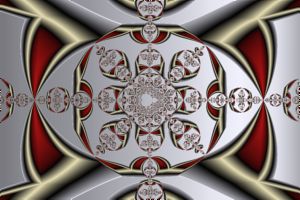 To produce a fractal image from this process, a window is mapped onto the
complex plane composed of a grid of points called pixels.
The number of rows and columns of the grid is determined by the size and
resolution of the window. For each pixel in the
window, we set z to an
initial z value, substitute the complex value associated with the
pixel into the formula for
c, and iterate the formula. If the iteration
terminates because the magnitude of
z exceeds the threshold, the
pixel is said to have escaped and is outside of the
Mandelbrot set. The pixel is colored based
on the number of iterations it took to escape and/or other characteristics of
z. If the magnitude
does not exceed the threshold when the maximum number of iterations is reached,
the pixel is assumed to be inside the Mandelbrot set and is usually colored black but
other colorings are possible based on the value of z
when the iteration is terminated. Of course, the pixel
may have escaped had we only executed additional iterations of the formula.
Fractals generated using this algorithm, are called
Mandelbrot fractals.
To produce a fractal image from this process, a window is mapped onto the
complex plane composed of a grid of points called pixels.
The number of rows and columns of the grid is determined by the size and
resolution of the window. For each pixel in the
window, we set z to an
initial z value, substitute the complex value associated with the
pixel into the formula for
c, and iterate the formula. If the iteration
terminates because the magnitude of
z exceeds the threshold, the
pixel is said to have escaped and is outside of the
Mandelbrot set. The pixel is colored based
on the number of iterations it took to escape and/or other characteristics of
z. If the magnitude
does not exceed the threshold when the maximum number of iterations is reached,
the pixel is assumed to be inside the Mandelbrot set and is usually colored black but
other colorings are possible based on the value of z
when the iteration is terminated. Of course, the pixel
may have escaped had we only executed additional iterations of the formula.
Fractals generated using this algorithm, are called
Mandelbrot fractals.
Julia Fractals
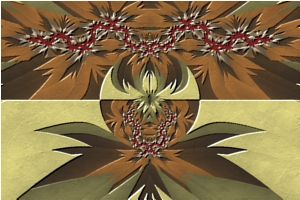 A 2nd algorithm begins each orbit by setting
z to the complex value associated with the
pixel, and c to a
fixed complex value, called the Julia Constant. The
rest of the algorithm is identical to the algorithm described above. Fractals
generated in this way, are called Julia fractals.
A 2nd algorithm begins each orbit by setting
z to the complex value associated with the
pixel, and c to a
fixed complex value, called the Julia Constant. The
rest of the algorithm is identical to the algorithm described above. Fractals
generated in this way, are called Julia fractals.
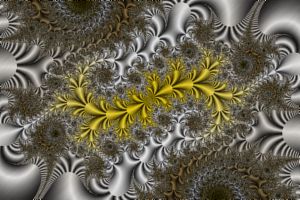 The choice of the Julia Constant in large part
controls the character of the resulting Julia
fractal. Surprisingly, the Mandelbrot fractal for
the same fractal formula provides the best interface for choosing the
Julia Constant. It turns out that the best choice
for a Julia Constant is a point on the complex
plane near the Mandelbrot set boundary. The resulting
Julia fractal will have many of the characteristics of the Mandelbrot fractal in the neighborhood of the
Julia Constant. The
Mandelbrot fractal can be used as a map for choosing the
Julia Constant. To this end, the
Fractal Science Kit allows you to click on any Mandelbrot fractal to produce a Julia fractal in a small window called the
Preview Window. Clicking on the image
displayed in the
Preview Window causes the Julia fractal to be displayed in a full size window
for further exploration.
The choice of the Julia Constant in large part
controls the character of the resulting Julia
fractal. Surprisingly, the Mandelbrot fractal for
the same fractal formula provides the best interface for choosing the
Julia Constant. It turns out that the best choice
for a Julia Constant is a point on the complex
plane near the Mandelbrot set boundary. The resulting
Julia fractal will have many of the characteristics of the Mandelbrot fractal in the neighborhood of the
Julia Constant. The
Mandelbrot fractal can be used as a map for choosing the
Julia Constant. To this end, the
Fractal Science Kit allows you to click on any Mandelbrot fractal to produce a Julia fractal in a small window called the
Preview Window. Clicking on the image
displayed in the
Preview Window causes the Julia fractal to be displayed in a full size window
for further exploration.
Convergent Fractals
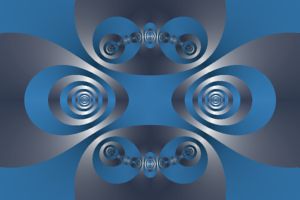 The algorithms above can be modified to watch for convergence rather than
divergence. In the process described above we execute the formula over and over
until the magnitude of z
exceeds some threshold. Fractals with this type of
termination condition are called Divergent
fractals. If instead, we execute the formula until the distance between the
point z and the orbit point just before
z is less than some threshold, we generate what is
called a Convergent fractal. This distance
represents how far z moved in the last iteration
of the orbit and the termination condition is basically checking that the orbit
is converging to single point. Which termination condition to use, depends
largely on the fractal formula. Like Divergent
fractals, Convergent fractals can be generated
using the Mandelbrot or Julia
algorithms.
The algorithms above can be modified to watch for convergence rather than
divergence. In the process described above we execute the formula over and over
until the magnitude of z
exceeds some threshold. Fractals with this type of
termination condition are called Divergent
fractals. If instead, we execute the formula until the distance between the
point z and the orbit point just before
z is less than some threshold, we generate what is
called a Convergent fractal. This distance
represents how far z moved in the last iteration
of the orbit and the termination condition is basically checking that the orbit
is converging to single point. Which termination condition to use, depends
largely on the fractal formula. Like Divergent
fractals, Convergent fractals can be generated
using the Mandelbrot or Julia
algorithms.
Newton Fractals
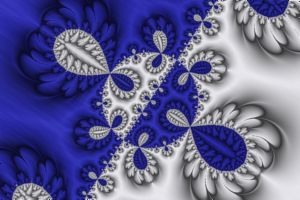 The most common example of a convergent fractal is a fractal based on
Newton's method of finding the roots of an
equation, called Newton fractals.
The most common example of a convergent fractal is a fractal based on
Newton's method of finding the roots of an
equation, called Newton fractals.
Newton fractals are a visual representation of a process called the Newton-Raphson method or simply Newton's method, named after Isaac Newton and Joseph Raphson, used to find the roots of an equation. Given an approximate value for one of the roots, a simple procedure is used to find a better approximation for the root. This procedure is applied over and over again, each time using the value obtained from the previous step, thereby moving closer and closer to the actual root. If this process converges to a value, you have found a root. The approximate value chosen at the beginning of the process, determines to which root you will eventually converge. If we assign each root a color, and we color each point on the complex plane based on the root to which that point converges, a Newton fractal is the result.
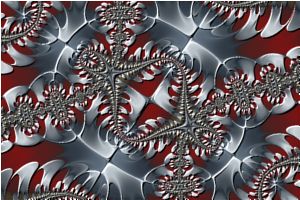 To create a Newton fractal for a given function f(z),
you set up a Julia fractal with a convergent
termination condition, based on Newton's method for
finding the roots of an equation; i.e., z = z-f(z)/f'(z),
where f'(z) is the derivative of
f(z). If you plug in a value for
z into the expression on the right side of the
assignment, the value of the expression is closer to the root than the original
value z. To generate the fractal, you start with a
complex value associated with a point on the complex plane and perform this
assignment until the value converges to a root, and then color the initial point
based on that root.
To create a Newton fractal for a given function f(z),
you set up a Julia fractal with a convergent
termination condition, based on Newton's method for
finding the roots of an equation; i.e., z = z-f(z)/f'(z),
where f'(z) is the derivative of
f(z). If you plug in a value for
z into the expression on the right side of the
assignment, the value of the expression is closer to the root than the original
value z. To generate the fractal, you start with a
complex value associated with a point on the complex plane and perform this
assignment until the value converges to a root, and then color the initial point
based on that root.
Of course, there are many other root-finding methods including: Schroder's method, Halley's method, Whittaker's method, Cauchy's method, the Super-Newton method (also called Householder's method), the Super-Halley method, the Chebyshev-Halley family of methods, and the C-Iterative family of methods. Fractals associated with each of these methods are supported by the Fractal Science Kit. Developers can set up a program to examine the fractals associated with these methods with just a few lines of code. See Solver Functions for details and example programs.
Built-in Fractal Equations
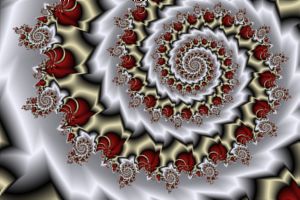 The
Fractal Science Kit fractal generator has over 180 built-in Fractal
Equations including Mandelbrot,
Mandelbar, Cubic,
Lambda, Phoenix,
Tetrate, Newton,
Nova, Barnsley,
Magnet, as well as studies in convergent fractals,
polynomial fractals, root-finding method based fractals, Julia maps, fractals
based on trigonometric and hyperbolic functions, and fractals based on
exponential formulas. Many of these programs define properties that can be used
to produce countless different variations. See
Built-in Fractal Equations
for a complete list.
The
Fractal Science Kit fractal generator has over 180 built-in Fractal
Equations including Mandelbrot,
Mandelbar, Cubic,
Lambda, Phoenix,
Tetrate, Newton,
Nova, Barnsley,
Magnet, as well as studies in convergent fractals,
polynomial fractals, root-finding method based fractals, Julia maps, fractals
based on trigonometric and hyperbolic functions, and fractals based on
exponential formulas. Many of these programs define properties that can be used
to produce countless different variations. See
Built-in Fractal Equations
for a complete list.
Orbit Traps
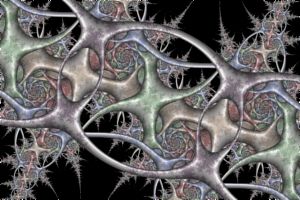 The Classic display of the different Mandelbrot and Julia
fractals (both divergent and convergent) iterates the fractal formula as
described previously and maps the resulting orbit to a color. Another popular
method of generating fractals is to define a set of geometric objects located on
the complex plane called Orbit Traps and during the
fractal iteration, keep statistics related to how close the orbit points come to
the Orbit Traps. Orbit Traps
provide a fertile ground for new and unusual fractals. You can combine the
built-in traps with your own Orbit Trap
instructions to produce unique fractal designs. The Fractal Science Kit fractal
generator supports
most of the common traps, including: Circle,
Cross, Cycloid of Ceva, Epicycloid,
Flower, Folium, Hypocycloid,
Lemniscate, Limacon,
Line, Oscillator,
Polygon, Rectangle,
Rose, Sectors, Shape,
Spiral, Star of David, Super Ellipse,
Swirl, and more. Many unusual traps are supported as well, including:
Apollonian Gasket, Apollonius
Grid, Borromean Rings,
Circle Inversion, Circle Web, Circular Vine,
Elliptic Circles, Daisy,
Epitrochoid Net, Epitrochoid
Rose, Faceted Polygon,
Farris Wheels, Farris Wheels Net,
Ford Circles, Fractal
Gasket, Harmonograph, Hyperbolic Circles,
Isogonal Polygon, Kleinian
Group, Koch Triangle,
L-System, Hypotrochoid Net,
Lemniscate Net, Limacon Net,
Maurer Rose, Nephroid Net, Parabolic Circles,
Parabolic Grid, Penrose Kite,
Polygon Net, Polygon Whirl, Schottky Group,
Sierpinski Triangle, Sound
Ornament, Spirolateral,
Star Polygon, Steiner Chain, Tangent Circles,
Unit Circle Group, and many more. See
Orbit Trap Types and
Built-in Orbit Traps for a
complete list.
The Classic display of the different Mandelbrot and Julia
fractals (both divergent and convergent) iterates the fractal formula as
described previously and maps the resulting orbit to a color. Another popular
method of generating fractals is to define a set of geometric objects located on
the complex plane called Orbit Traps and during the
fractal iteration, keep statistics related to how close the orbit points come to
the Orbit Traps. Orbit Traps
provide a fertile ground for new and unusual fractals. You can combine the
built-in traps with your own Orbit Trap
instructions to produce unique fractal designs. The Fractal Science Kit fractal
generator supports
most of the common traps, including: Circle,
Cross, Cycloid of Ceva, Epicycloid,
Flower, Folium, Hypocycloid,
Lemniscate, Limacon,
Line, Oscillator,
Polygon, Rectangle,
Rose, Sectors, Shape,
Spiral, Star of David, Super Ellipse,
Swirl, and more. Many unusual traps are supported as well, including:
Apollonian Gasket, Apollonius
Grid, Borromean Rings,
Circle Inversion, Circle Web, Circular Vine,
Elliptic Circles, Daisy,
Epitrochoid Net, Epitrochoid
Rose, Faceted Polygon,
Farris Wheels, Farris Wheels Net,
Ford Circles, Fractal
Gasket, Harmonograph, Hyperbolic Circles,
Isogonal Polygon, Kleinian
Group, Koch Triangle,
L-System, Hypotrochoid Net,
Lemniscate Net, Limacon Net,
Maurer Rose, Nephroid Net, Parabolic Circles,
Parabolic Grid, Penrose Kite,
Polygon Net, Polygon Whirl, Schottky Group,
Sierpinski Triangle, Sound
Ornament, Spirolateral,
Star Polygon, Steiner Chain, Tangent Circles,
Unit Circle Group, and many more. See
Orbit Trap Types and
Built-in Orbit Traps for a
complete list.
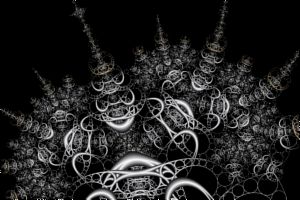 The Orbit Trap Properties Pages allow
you to define a list of traps and specify how to process them. You can blend the
traps together using various blending techniques (e.g., harmonic mean) or
process them separately. You can modify the trap's position/angle per iteration,
based on values of the current/previous orbit points. You can control the trap
envelope. You can transform input points prior to passing them to the trap.
These are but a few of the many different Orbit Trap options available.
The Orbit Trap Properties Pages allow
you to define a list of traps and specify how to process them. You can blend the
traps together using various blending techniques (e.g., harmonic mean) or
process them separately. You can modify the trap's position/angle per iteration,
based on values of the current/previous orbit points. You can control the trap
envelope. You can transform input points prior to passing them to the trap.
These are but a few of the many different Orbit Trap options available.
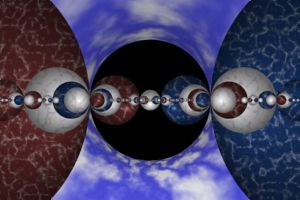 Some of the orbit traps are stand-alone fractals in their own right. For
example, the Kleinian Group trap allows you to
produce Quasifuchsian, Single
Cusp, and Double Cusp,
Two-Generator Group fractals described in the book
Indra's
Pearls - The Vision of Felix Klein by David Mumford, Caroline
Series, and David Wright. The Schottky Group trap
explores the world of nesting Schottky disks and groups of
Mobius maps that form the basis for the
Two-Generator Group fractals above. Schottky Group
fractals are also described in the book Indra's
Pearls. The
L-System trap allows you to create an orbit trap
using a set of statements that define an L-System
or Lindenmayer System.
Lindenmayer System fractals were developed in 1968 by Aristid
Lindenmayer. The Apollonian Gasket, Circle Inversion,
Ford Circles, and
Unit Circle Group traps also produce stand-alone
fractals. Other traps (e.g.,
Epitrochoid Net, Epitrochoid Rose,
Farris Wheels, Farris Wheels
Net,
Harmonograph, Hypotrochoid Net,
Isogonal Polygon, Maurer Rose, Sound Ornament,
Spirolateral, Star Polygon) can produce
beautiful mathematical art when combined with complex transformations and other
supported features.
Some of the orbit traps are stand-alone fractals in their own right. For
example, the Kleinian Group trap allows you to
produce Quasifuchsian, Single
Cusp, and Double Cusp,
Two-Generator Group fractals described in the book
Indra's
Pearls - The Vision of Felix Klein by David Mumford, Caroline
Series, and David Wright. The Schottky Group trap
explores the world of nesting Schottky disks and groups of
Mobius maps that form the basis for the
Two-Generator Group fractals above. Schottky Group
fractals are also described in the book Indra's
Pearls. The
L-System trap allows you to create an orbit trap
using a set of statements that define an L-System
or Lindenmayer System.
Lindenmayer System fractals were developed in 1968 by Aristid
Lindenmayer. The Apollonian Gasket, Circle Inversion,
Ford Circles, and
Unit Circle Group traps also produce stand-alone
fractals. Other traps (e.g.,
Epitrochoid Net, Epitrochoid Rose,
Farris Wheels, Farris Wheels
Net,
Harmonograph, Hypotrochoid Net,
Isogonal Polygon, Maurer Rose, Sound Ornament,
Spirolateral, Star Polygon) can produce
beautiful mathematical art when combined with complex transformations and other
supported features.